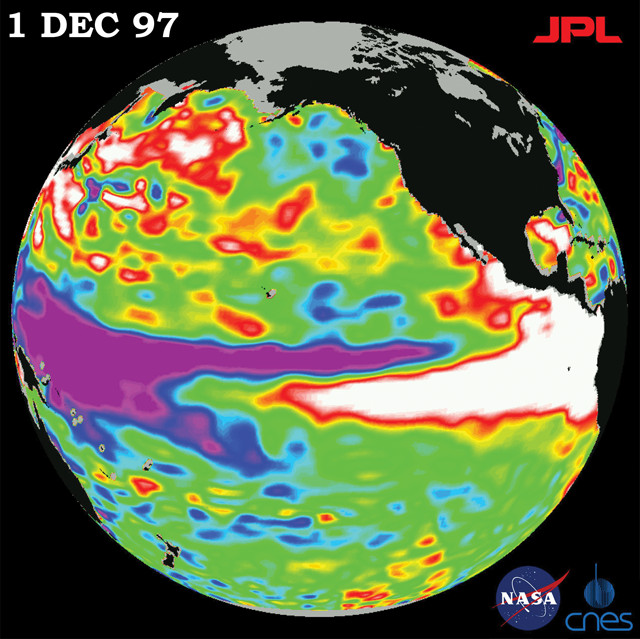
by Mary Caperton Morton Friday, January 30, 2015

A TOPEX/Poseidon satellite image shows unusually high heat storage (white) in the ocean off the west coast of Central and northern South America related to El Niño conditions in December 1997. Credit: NASA.
In 1997 and 1998, warmer-than-average temperatures brought on by El Niño weather patterns led to copious rainfall and extensive flooding in northern Peru. The rising waters wiped out crops, drowned livestock, cut off bridges, and caused prolonged famine in many rural villages. Now, a new study that tracked long-term health impacts on children from the affected region has found that those born during or soon after the floods continued, a decade later, to bear signs of the hardship endured early in their lives.
“This El Niño was a complete disaster for some villages,” says William Checkley, an epidemiologist at Johns Hopkins University in Baltimore and a co-author of the new study, published in Climate Change Responses. “We wanted to see if this event had a long-term effect on human health in the region.”
To address that question, in 2008, Checkley and his colleagues collected measurements from more than 2,000 children living in a cluster of villages around hard-hit Tumbes, Peru. The children were born between 1991 and 2001, giving the team a sampling of kids born before, during and after the 1997–1998 El Niño event.
They found that children born during and up to three years after the disaster were, on average, shorter than peers born earlier or later, with a lower height-for-age average — a measurement used by the World Health Organization to track nutritional health — that persisted 10 years later.
Children born during the disaster or in its aftermath lacked a diet adequate for optimal growth, and the scarcity of nutrient-rich and energy-dense foods led to significantly decreased lean muscle mass in this group, according to the study. “This is not surprising, given that body composition [at later ages] is strongly influenced by the nutritional environment experienced in early life,” Checkley says. Just as the effects of natural disasters on trees are sometimes recorded in tree rings, he says, “exposure to severe weather events can leave long-lasting marks in children.” Checkley notes, however, that the stunted growth patterns he and his colleagues observed, although persistent, may not necessarily be permanent, if the children continue receiving proper nutrition.
“There’s a long history of studies looking at long-term effects of adverse conditions early in life,” says Amir Jina, an environmental economist at the University of Chicago who was not involved in the new study. This study offers “a very clear look” at how one disaster has followed people for years, Jina says; other recent research, he says, suggests it’s “absolutely possible” that environmental conditions can have lifelong impacts on human health.
Previous studies have linked El Niño weather patterns to outbreaks of infectious diseases like malaria, dengue fever and cholera. The new findings further highlight the need for more preparedness in El Niño years, Checkley says. El Niño conditions occur about every two to seven years and can sometimes be predicted several years in advance, although the hardest hit regions and specific consequences are more difficult to pinpoint ahead of time.
Peru has greatly improved its preparedness and response capabilities to natural disasters since the 1997–1998 event, Checkley says. “Now, Peru has an early warning system to predict bad El Niño years, and as the event unfolds the government can set up additional support in areas expected to be hit,” he says.
Long-term health effects can also be expected in other regions of the world where El Niño exerts an influence but where governments lack stability and have access to fewer resources, highlighting the need for international disaster outreach, Jina says. This paper fills in details about how “we can mitigate vulnerability to natural disasters, such as [providing] reliable nutrition,” he says. “Continuing to fill out this picture with these kinds of studies is incredibly important.”
© 2008-2021. All rights reserved. Any copying, redistribution or retransmission of any of the contents of this service without the expressed written permission of the American Geosciences Institute is expressly prohibited. Click here for all copyright requests.